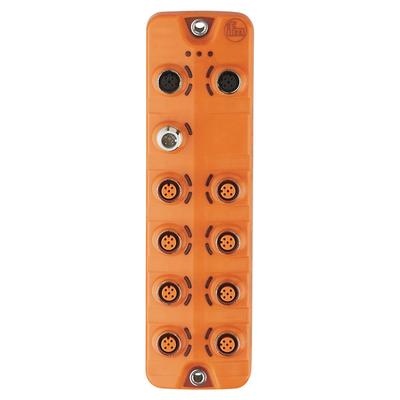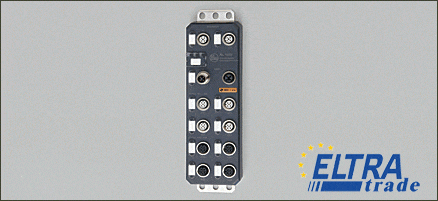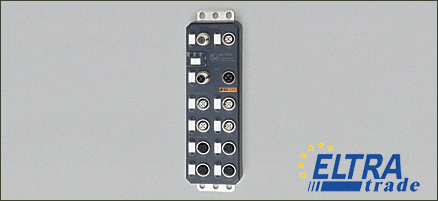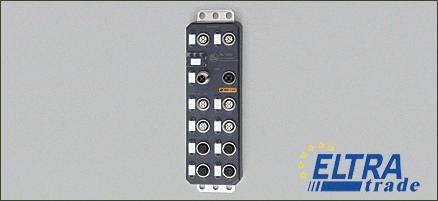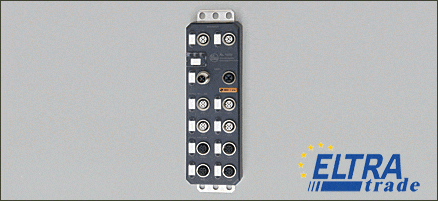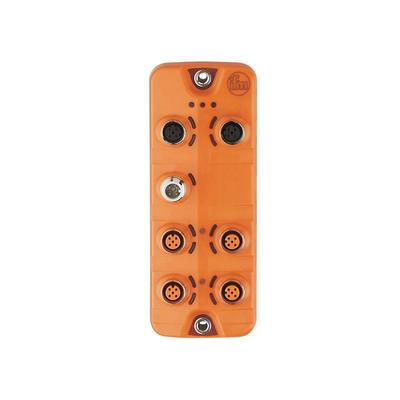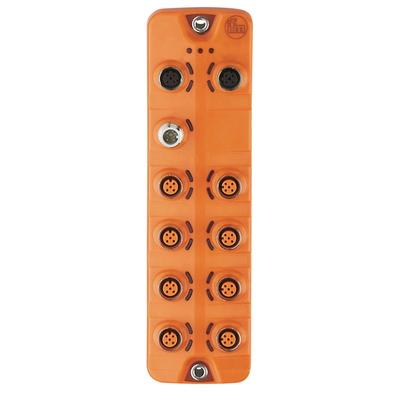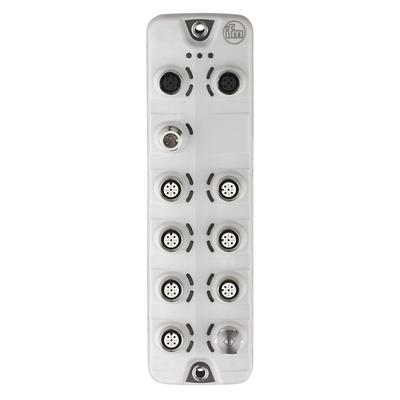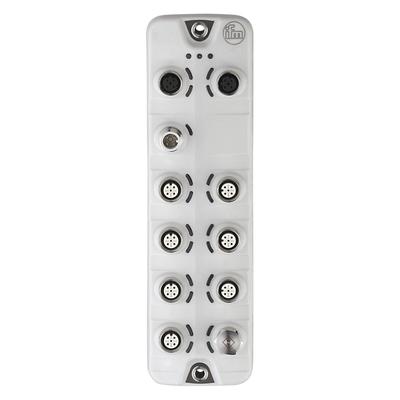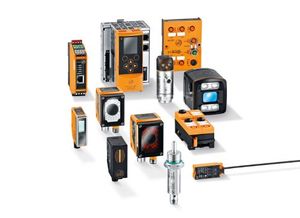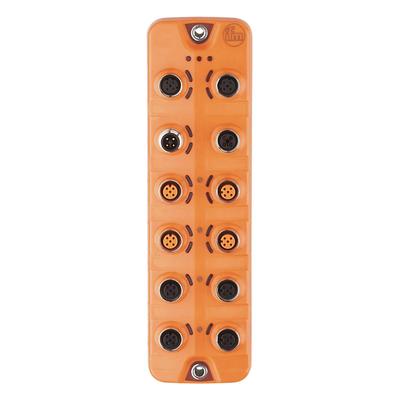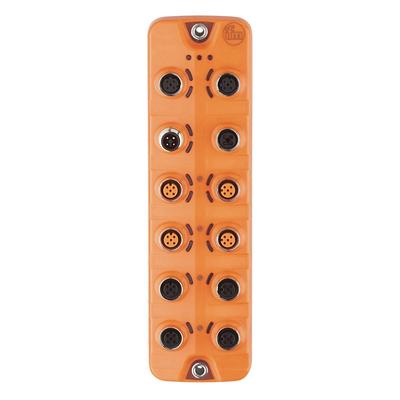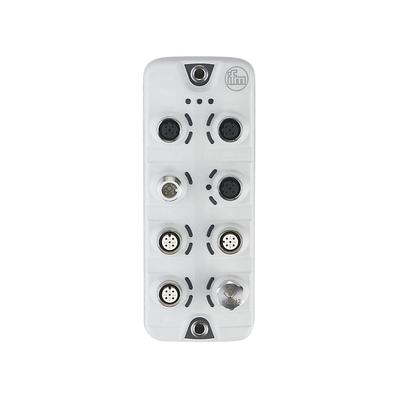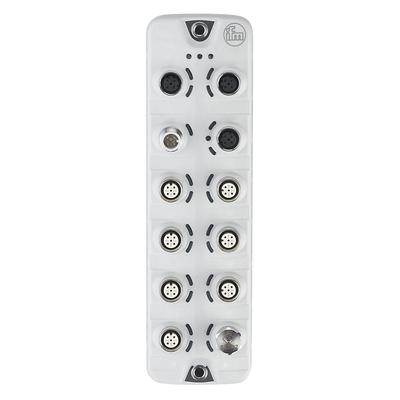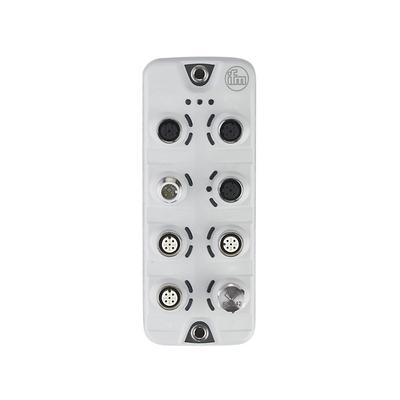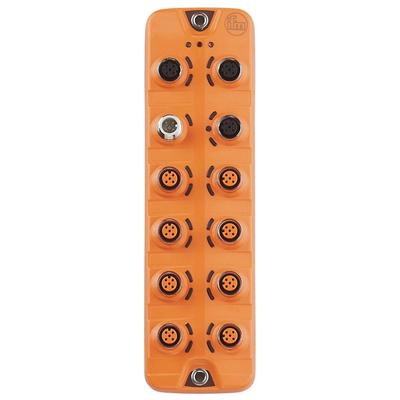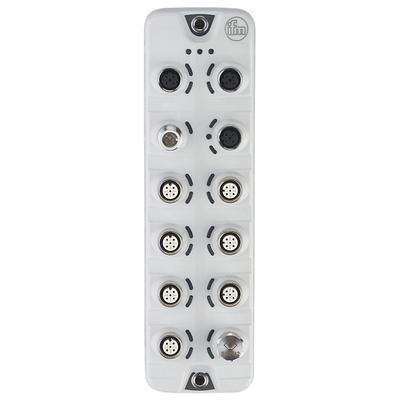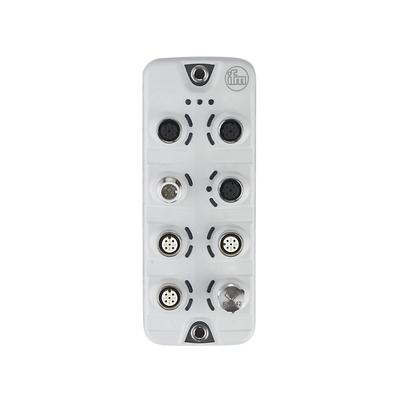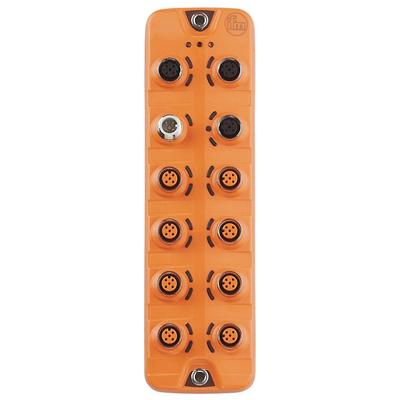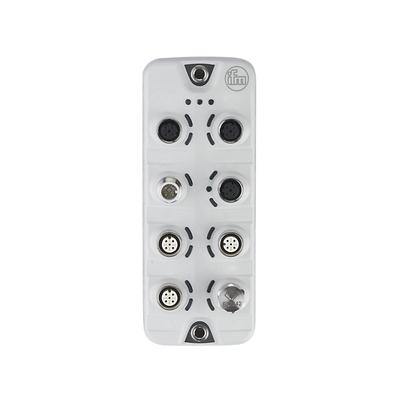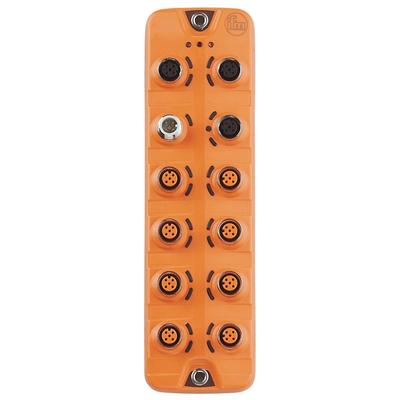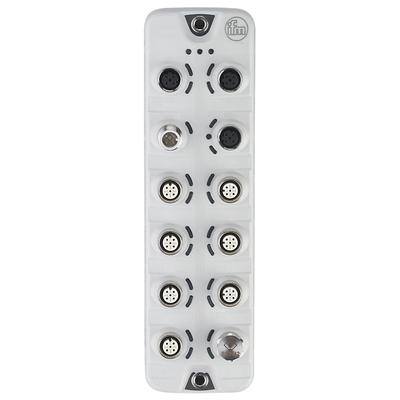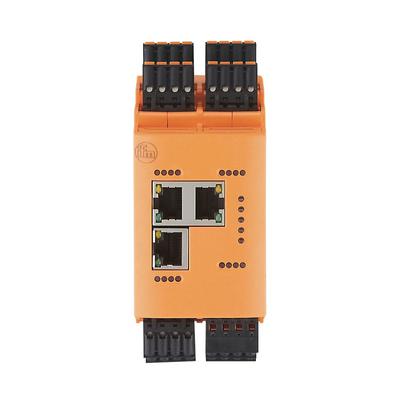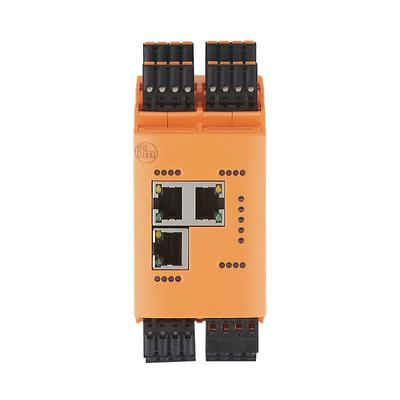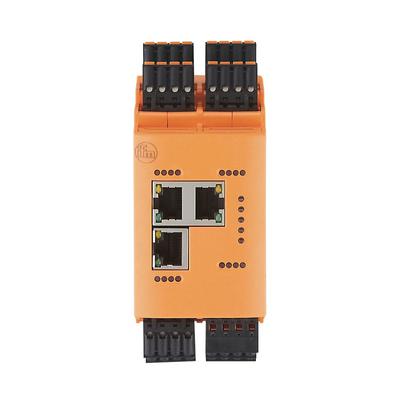IFM IO-Link Masters
- 20...30 DC; (US; according to SELV/TBTP)
- 300...3900; (US)
- 16; (configurable)
- DataLine
- DC
- M12 Connector
IO-Link master with Profinet interface, max. 8 IO-Link ports / max. 12 digital inputs / max. 8 digital outputs, I/O modules for field applications
IO-Link master with Profibus interface, max. 8 IO-Link ports / max. 12 digital inputs / max. 8 digital outputs, I/O modules for field applications, Sockets M12 x 1
IO-Link master with EtherNet/IP interface, max. 8 IO-Link ports / max. 12 digital inputs / max. 8 digital outputs, I/O modules for field applications, Sockets M12 x 1
IO-Link master with EtherCat interface, max. 8 IO-Link ports / max. 12 digital inputs / max. 8 digital outputs, I/O modules for field applications, Sockets M12 x 1
IO-Link Master SL PN 4P IP67
IO-Link Master SL PN 8P IP67
IO-Link Master SL PN 8P IP69K
IO-Link Master SL EIP 8P IP69K
IO-Link Master PL PN 4P IP69K
IO-Link Master PL PN 8P IP67
IO-Link Master PL PN 8P IP69K
IO-Link Master PL EIP 4P IP69K
IO-Link Master PL EIP 8P IP67
- DataLine
- DC
- M12 Connector
- DataLine
- DC
- M12 Connector
- DataLine
- DC
- M12 Connector
- DataLine
- DC
- M12 Connector
- DataLine
- DC
- M12 Connector
- DataLine
- DC
- M12 Connector
- DataLine
- DC
- M12 Connector
- DataLine
- DC
- M12 Connector
- DataLine
- DC
- M12 Connector
- DataLine
- DC
- M12 Connector
- DataLine
- DC
- M12 Connector
- CabinetLine
- DC
- RJ45 Connector
- CabinetLine
- DC
- RJ45 Connector
- CabinetLine
- DC
- RJ45 Connector
- CabinetLine
- DC
- RJ45 Connector
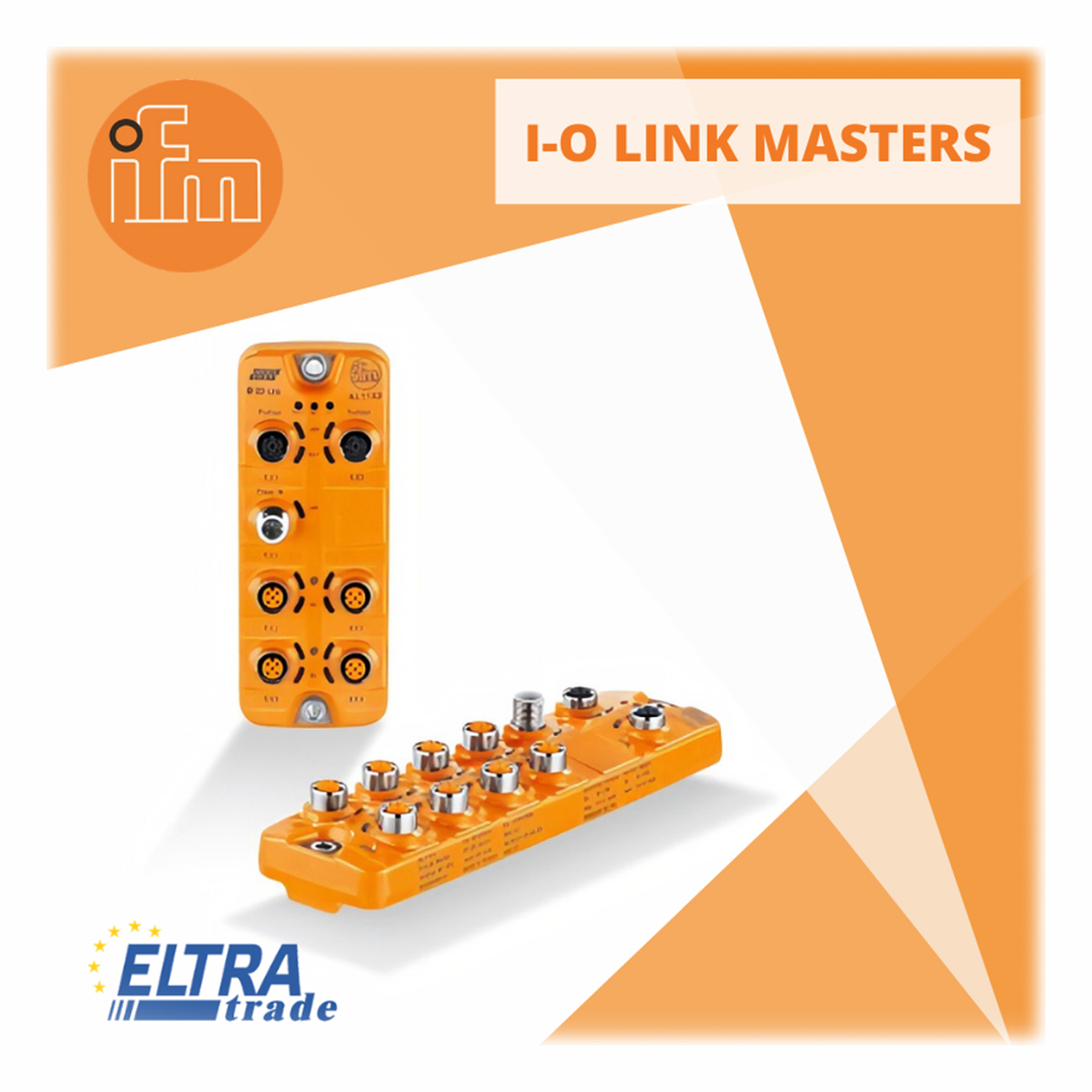
IFM I/O Link master is a special gateway for connection IO-Link devices. It can connect up to eight different devices to a single outlet (sensors, modules, valves, etc.). Through IO link master all data and parameters transmits to control systems.
The process of intellectualization of sensors is still ongoing; more and more new standards for data exchange between devices are emerging. This is precisely what the IO-Link Protocol became. Leading manufacturers of sensors and control systems have developed it. The result is a fieldbus-independent interface for automation. It provides the user with a point-to-point connection without complex addressing.
IO-Link allows sensors to transmit information about their status and events that have occurred, including allowing the settings of these sensors to be changed remotely. The IFM company is directly related to the creation of IO-Link and related devices, such as IFM IO-Link master modules, which we will talk about in more detail today.
Overview of IO-Link Masters by IFM
The IO-Link master replaces the traditional analog input card with a digital communication link between the master and the device. Up to 8 IO-Link devices, such as sensors, valves, and I/O modules, can be connected to one master, depending on the master configuration. The master transfers machine data, process parameters, and diagnostic information to the PLC controller or directly to a higher-level Industrial IoT (IIoT) control system.
IFM has created the IO-Link Master series to help realize Industry 4.0. IFM is consistently promoting its IO-Link Master series as the fourth industrial revolution evolves.
Many of the benefits of Industry 4.0 and IIoT overlap with those of IO-Link. IFM currently has six IO-Link masters with a choice between three separate protocols: EtherNet/IP, Modbus TCP, and PROFINET IO.
IFM's IO-Link Master products are, simply put, “enabling the development of Industry 4.0 and IIoT.” The integration of IO-Link Master with sensors and actuators at the field level provides point-to-point communication all the way to the upper levels of the enterprise resource planning (ERP) data pyramid.
Industry 4.0 is actually the fourth industrial revolution. The first industrial revolution was the use of water and steam power, the second was the use of electricity, followed by the digital revolution. The goal of Industry 4.0 is to fully integrate the communication process used in manufacturing to improve the efficiency of enterprises through IIoT, industrial automation, data exchange, and manufacturing technologies.
There are several series of IFM IO Link master for different applications:
- Filed mountable for industrial automation
- Field mountable for high pressure cleaning
- DIN rail mountable for control cabinets
IO-Link Technology
In the fast-paced industrial technology and factory automation world, IFM is committed to innovation, efficiency, and resource conservation. We strive for universal protocols and the development of interconnection between ecosystems.
IFM is a founding member of the IO-Link consortium. This group works with industry leaders to advance technology and integration, maintain quality standards, conduct workshops, and more. The consortium has more than 250 members and continues to grow.
IO-Link is a global communications standard (IEC 61131-9) that revolutionizes how you connect and interact with digital sensors and actuators. Using wired or wireless configurations, this technology solves integration problems and allows devices to exchange rich data sets seamlessly.
In addition to providing fast and cost-effective communication between devices to reduce downtime, IO-Link offers other benefits.
Data storage
IO-Link master module can store up to 2 KB of parameters that affect the operation of the sensor or actuator. If a sensor needs to be replaced, the IO-Link master quickly and automatically writes the parameters of the replaced IO-Link sensor to the new sensor. When the sensor needs to operate with new parameters, this information can be sent remotely and is automatically updated. After commissioning, format, or recipe changes, no manual intervention is required to restart the equipment. This saves valuable time and minimizes the chance of human error.
Remote configuration and monitoring
Device and sensor parameters can be easily changed remotely as needed, saving valuable time in production, such as during product changes (moving from small bottles to large bottles on a production line). This also makes it easier to reconfigure devices in hard-to-reach places. Sensor outputs and status alerts can be monitored remotely in real time, helping you quickly identify and resolve problems before they cause downtime.
Diagnostic capabilities
Intelligent sensors equipped with IO-Link can report their status via an IO-Link master to the PLC. Before processes stop, you will immediately know whether the sensor needs replacement, requires maintenance, or has an error. This allows you to optimize machine maintenance schedules and diagnose problems with a specific sensor without shutting down an entire line or equipment.
Cost savings
In addition to saving time, which results in a higher return on investment, IO-Link also reduces overall system costs. The sensors do not require an Ethernet interface; they rely on the IO-Link communication interface, which is much more cost-effective. Because IO-Link does not require unique or complex wiring, material costs are also lower. You can use the same cost-effective, unshielded cables for conventional discrete I/O to make wiring inexpensive and straightforward. IO-Link also eliminates the need for analog cards. This also reduces the wires you need to purchase and store in stock.
Overview of the production workshop
IO-Link acts as the eyes and ears of your plant, providing never-before-seen process information that allows you to make decisions to reduce downtime. For example, if a sensor is short, IO-Link alerts you, pinpoints the exact location of the sensor, and guides you straight to it, providing real-time diagnostic information. Hence, you know what's causing the problem.
Vendor independence
IO-Link is a vendor-independent technology that allows IO-Link devices to be used in any standard industrial fieldbus environment.
Benefits of Using IFM IO-Link Masters
IFM master IO-Link is an industrial networking device designed to facilitate communication between sensors and actuators in industrial automation and control systems. IO-Link is a standardized communication protocol used in manufacturing and industrial environments. Here are some benefits of using IFM IO-Link masters.
- Improved data transmission. IFM IO-Link masters provide a high-speed and reliable communication channel between sensors/actuators and the control system. This ensures that data is transmitted accurately and in real time, which is crucial for process control and monitoring.
- Increased flexibility. IO-Link is a point-to-point communication protocol, which means that each sensor or actuator can be individually addressed and configured. IO-Link masters allow for easy parameterization and reconfiguration of devices, making them more flexible and adaptable to changing production requirements.
- Enhanced diagnostics. IO-Link devices provide detailed diagnostic information, allowing for quick identification of faults or issues in the system. IFM IO-Link masters can collect and process this diagnostic data, enabling predictive maintenance and reducing downtime.
- Simplified wiring. Traditional industrial networks often require complex wiring schemes. IO-Link uses a simple, standardized three-wire connection (power, ground, and data) for all devices. IO-Link masters help reduce wiring complexity, leading to cost savings and easier installation.
- Integration with existing systems. These devices are designed to work seamlessly with various PLCs (Programmable Logic Controllers), SCADA (Supervisory Control and Data Acquisition) systems, and other automation platforms. This makes it easier to integrate IO-Link devices into existing control systems.
- Energy efficiency. IO-Link devices are designed with energy efficiency in mind. IFM IO-Link masters can monitor and control the power consumption of connected devices, contributing to energy savings in industrial processes.
- Remote configuration. Such equipment can be configured and monitored remotely, which reduces the need for on-site maintenance and allows for centralized control and troubleshooting.
- Cost savings. The benefits of reduced wiring complexity, enhanced diagnostics, and energy efficiency can lead to significant cost savings over time. Additionally, the flexibility of IO-Link allows for more efficient use of resources and better optimization of industrial processes.
- Increased productivity. By providing real-time data and diagnostics, IO-Link masters help improve overall system uptime and productivity. Operators can quickly identify and address issues, minimizing production interruptions.
- Future-proofing. IO-Link is an industry-standard protocol that is widely adopted. Using IO-Link master ensures that your automation system is compatible with a broad range of sensors and actuators, providing a level of future-proofing for your industrial processes.
IFM IO-Link Masters Compatibility with IFM Sensors and Devices
IFM offers one of the largest selections of sensors and other IO-Link-compatible devices. Their wide offer allows you to implement a comprehensive digital communication system across all your machines and processes.
IFM IO-Link masters are designed to be compatible with a wide range of IFM sensors and devices, as well as third-party IO-Link-compatible sensors and actuators. IFM is a reputable manufacturer of industrial sensors, so they ensure that their IO-Link masters work seamlessly with their own products. Here's how compatibility typically works.
IFM sensors
IFM IO-Link masters are specifically engineered to work with IFM sensors. These sensors include proximity sensors, photoelectric sensors, pressure sensors, flow sensors, temperature sensors, and many others. IFM designs both their sensors and IO-Link m1asters to meet industry standards, ensuring compatibility.
IFM IO-Link devices
IFM offers a range of IO-Link devices that are designed to work effortlessly with IFM IO-Link masters. These devices include IO-Link-enabled actuators, valve connectors, signal converters, and more. The compatibility is built into both the hardware and software of these products.
Third-party IO-Link devices
IFM IO-Link masters are also designed to be compatible with IO-Link devices from other manufacturers. IO-Link is an open and standardized communication protocol, so any IO-Link-compliant device should be compatible with IFM IO-Link masters as long as it adheres to the IO-Link standard.
Parameterization and configuration
IFM IO-Link masters typically come with software tools that allow you to easily parameterize and configure connected devices, including IFM sensors and third-party IO-Link devices. This helps ensure proper communication and functionality.
Data Integration
IFM IO-Link master can collect data from various sensors and devices, regardless of the manufacturer, and provide this data to your control system or PLC. This makes it easy to incorporate a mix of sensors and devices from different suppliers into your industrial automation setup.
Recap of IO-Link Masters and Their Significance
The IFM IO-Link master communicates with IO-Link devices, collects data from them, and transfers it to the higher-level bus system. The main features of such devices are.
- For connecting up to eight IO-Link devices.
- Machine data, process parameters, and diagnostic data are reliably transferred to the controller.
- Simultaneous exchange of data with the controller and the IT world.
- Field units and control cabinets.
- With integrated fieldbus interface.
There are two types of IO-Link masters: field applications and control cabinets. Below, we will take a closer look at both types of these devices.
IO-Link masters for field applications
IO-Link masters for field applications are gateways for connecting up to eight IO-Link devices, including sensors, valves, or binary I/O modules. Some versions have ports designed as B ports that provide auxiliary power for connecting IO-Link drives. The master transfers machine data, process parameters, and diagnostic data to the controller. The product range includes Profinet, EtherCat, Ethernet/IP, Profibus, and AS-Interface interfaces.
Excellent electromagnetic stability, wide temperature range, high degree of protection, and rugged housing allow the device to be used in harsh industrial environments. The AS-interface master has quick installation technology using a slide that fixes the top and bottom.
IO-Link masters for control cabinets
The IO-Link master for installation in the control cabinet has an integrated web server for configuration and diagnostics. It transfers machine data, process parameters, and diagnostic data via Profinet or Ethernet/IP to the controller. The device features a second Ethernet port with a built-in switch to ensure that data can be processed by IT and used across multiple plants or even worldwide. This dual port allows all connected IO-Link devices to be directly networked with a local server using a parallel communication path called the “Y path”. The integrated interface software LINERECORDER AGENT provides communication with the server.
